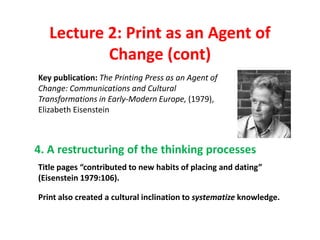
Nr2 print as an agent of change
- 1. Lecture 2: Print as an Agent of Change (cont) Key publication: The Printing Press as an Agent of Change: Communications and Cultural Transformations in Early-Modern Europe, (1979), Elizabeth Eisenstein 4. A restructuring of the thinking processes Title pages “contributed to new habits of placing and dating” (Eisenstein 1979:106). Print also created a cultural inclination to systematize knowledge.
- 2. Print formats re-structured the ‘cognitive space’ They imposed a peculiarly Indo-European filter Print reifies the Aristotelian notion of contrarity and binary logic. Question: Is the hyperlinked hologram world of the Internet ‘linear’? Print restructures the perception of time into the linear pattern of narrative Renaissance man onwards saw time as an object to be visualised. Question: Did print really create a linear sense of time? Question: Are attention spans really shorter in the modern era?
- 3. 5. A new industry of information workers was created. Intangible information could now be sold as an information product. 6. Novelty became valorised for its own sake. ‘Original’ once meant ab origine. Now it meant novelty. Novelty - the latest thing - acquired commodity value ‘Newe Herrings, new, wee must crye!’ Thomas Nashe, 1592 Defoe and Richardson (mid 18thc): the first authors of fiction who were genuinely ‘original’ in their plots
- 4. 7. Print provoked censorship A threat! Now information could be managed by the hoi polloi and not authority A dialectic began: censorship versus free expression Censors The press Guild censorship: eg. Culpepper State censorship: rise of the Stationers’ Hall: eg.Ben Jonson (right) Church censorship: eg. Martin Marprelate Some clerics welcomed print; others feared it
- 5. Question: why did the 18thc also see provocative opinions- if they were not seditious - being increasingly tolerated in newspapers? Question: has state censorship in Western culture really lapsed?
- 6. Question: ‘how many angels can dance upon the head of a pin?’ Caution: the question may not be as foolish as it seems…
- 7. 8. Print ‘fixed’ material from the past. ‘Typographical fixity’ (Eisenstein 1979: 1, 116-20) “Works ‘brought to light’ in this period [from 16thc onwards] remained in the public domain forever after” (Eisenstein 1979:210). 9. Print also ‘fixed’ ideas for future examination. • A book can be successively revised and reprinted; ephemera are lost Plays were considered ephemeral until early 17th century • A good memory was now unnecessary • Book packaging imposed a spurious perfection on volatile manuscripts. • A book conveys ‘immortality’ on an author Question: Did text really fix ideas?
- 8. 10. Printed documents had high credibility and prestige. The oral word acquired substance. Books became status icons. Appeal to exclusivity 11. Print created the concept of intellectual ownership. The book invented the author… and the author invented copyright “Printing forced legal definitions of what belonged in the public domain…the terms plagiarism and copyright did not exist for the minstrel. It was only after printing that they began to hold significance for the author" (Eisenstein 1979:120)
- 9. Question: Who is the ‘author’ of a book today? Does it matter? How could reviewers critique a book written by a computer program?
- 10. 12. Print developed the concept of privacy as an entitlement Question: was print really responsible for the growth of privacy? Or did privacy really grow with the development of chimneys?
- 11. 13. Print became a tool of self-fashioning Self-aggrandisement. Automythopoeia. Bloggo ergo sum?
- 12. Summary Eisenstein argues that print was an ‘agent of change’ that had an effect on:- · The Rise of Science: Cartography, Astronomy, Botany etc; The Rise of Exploration and Exploitation of the Natural World; Scepticism and rejection of classical authority and deductive principles (arguing from authority). · Religion: Reformation, Challenges to the Authority of the Church, Religious Wars, Rise of Secularism; 18thc anti-clericalism · The Early Modern Economy: The Rise of Mercantilism and early Capitalism; the commodification of the word · The Sense of Individuality and Self-Reliance in Western Culture: The Rise of Bourgeoisie and the sturdy individual, private, subjective, independent · Medieval Universities: Challenges to the Old Authorities and Old Methods of Learning, The Move towards the 17thc Enlightenment (see Habermas and Lecture Three); major shifts in sensibility (eg joke books became more human…)
- 13. Assignment: Eisenstein argues that other conditions present in northern European culture allowed print to act as an agent of change. Print was not always or necessarily itself an agent of change. Write a short 500-word paper in an academic register and format, with citations and a terse bibliography, on the topic: If we accept that the Internet is inarguably correlated with ‘change’ in processes of human behaviour and cognition, is the Internet by itself an agent of change? Or is it merely associated with changes in behaviour and cognition which may be occurring by means of other agents entirely? Conceivably, are both arguments defensible? Advance your argument with illustrative examples and citations.